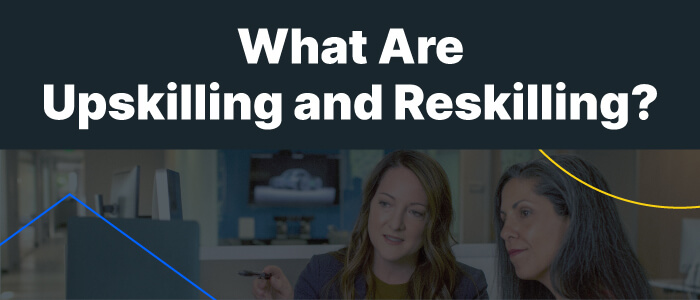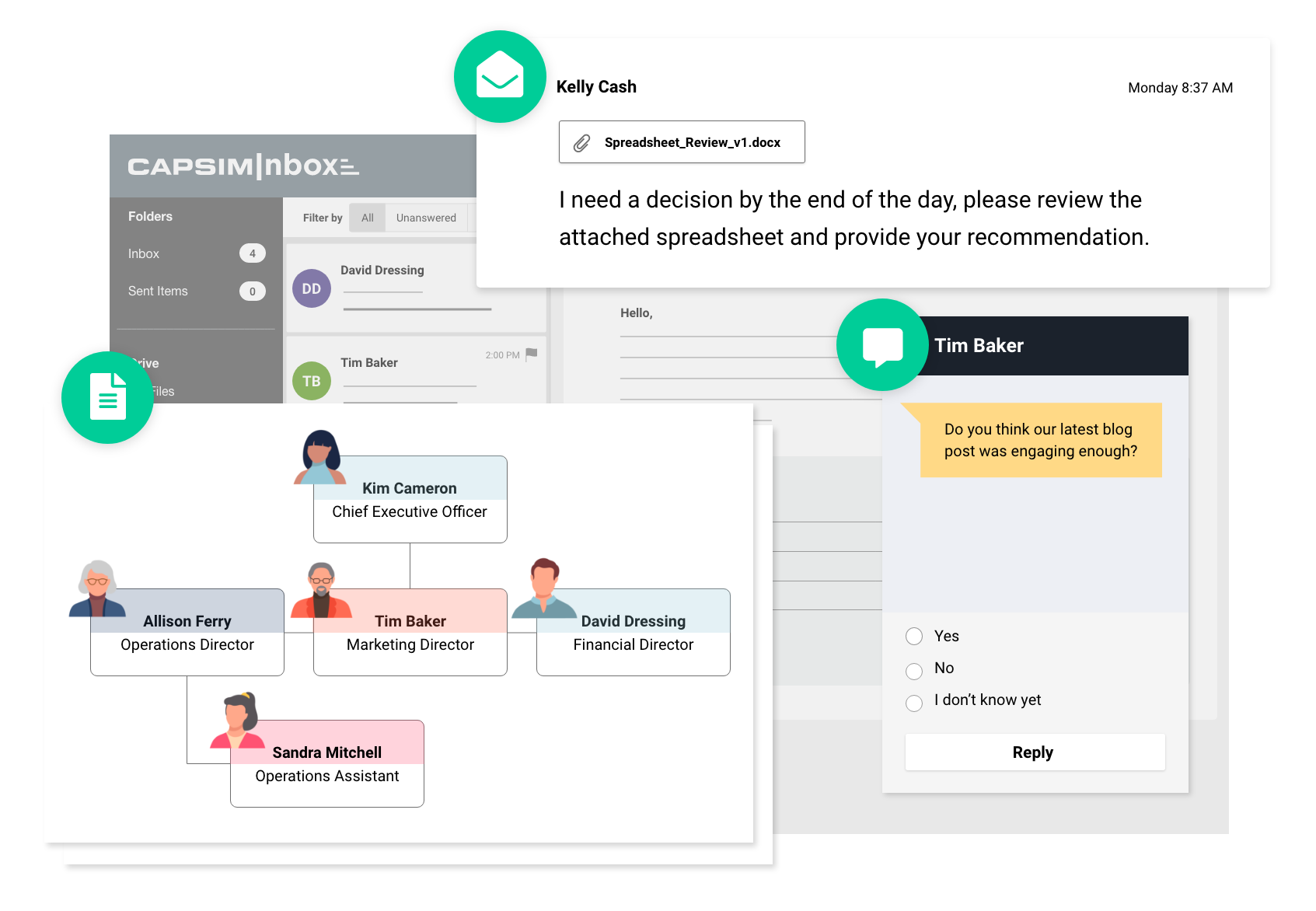What are Upskilling and Reskilling?
March 3, 2022

Every year there are fads and buzzwords in learning and development—some hot new technology or approach to training that you must try or you’re going to fail. Upskilling and reskilling, for as much buzz as they’ve gotten, are not fads that will fade away.
Back in 2018, the World Economic Forum’s “Future of Jobs Report” predicted that by 2022, 75 million jobs across the 20 largest economies in the world would be displaced by artificial intelligence, automation, and other emerging technologies by 2022.
Well, 2022 is here, and with an ongoing pandemic to boot, it’s safe to say the World Economic Forum’s prediction has come true. And it’s brought more high-talent job openings than skilled workers to fill them. That’s where upskilling and reskilling come in.
In this article, we’ll discuss what each of these concepts is, the advantages they offer, and when to pursue each in your corporate learning and development strategy.
Why Upskilling and Reskilling are Vital in the Future of Work
What’s the importance of upskilling and reskilling in the modern professional environment? Look at it this way: how much has your organization changed in the past five years? Are you still using all the same skills—and only those skills—as the day you were hired?
Business processes, technologies, organizational goals: These things are always changing. To remain competitive in the current, fast-paced business environment, your company needs to be equipped to adapt to rapid change by developing technical skills and soft skills in the workplace.
Upskilling and reskilling can also help you with your hiring efforts. The labor shortages of 2021 have persisted into 2022. These shortages mean that filling positions — especially high-skill jobs — is even more challenging than usual. It takes time to find the right candidate, take them through the hiring process, wait for them to notify their current employer, and train them.
Upskilling or reskilling a talented worker already in your organization can be much quicker and more accessible for organizations. In short, taking this approach can help your organization stay agile and fully staffed, making it easier to outperform your competitors.
What is Upskilling?
What is upskilling? Upskilling is a corporate learning and development process that teaches existing employees new skills to help them perform their current job more effectively.
Upskilling is an excellent option for hanging onto top talent in your organization and preventing their skillsets from becoming obsolete. You can use upskilling to improve job performance for struggling workers and close skills gaps you notice developing on your team.
One common use of upskilling is related to technological changes. For example, suppose your workplace has gone remote or partially remote in the past few years. In that case, your employees may need to be upskilled to use video conferencing tools or asynchronous meeting tools effectively.
Remember: soft skills are skills, too! Consider a long-standing employee who has been in the same position for several years. You could use upskilling to teach them additional leadership and management skills, enabling them to serve the organization and the rest of their team better by serving as a “team leader.”
Related Read: Filling the Gaps: The 5 Top Soft Skills Employers Want Right Now
The key thing to remember about upskilling is that you aren’t changing the employee’s job function drastically: You’re giving them the knowledge to complete their current job duties more efficiently.
The main benefit of upskilling is that it makes your workforce more adaptable and resilient. Instead of losing hard-working employees who are a perfect cultural fit due to performance challenges, upskilling allows you to invest in these workers and improve their skill set in-house.
In other words, instead of spending time and resources on recruiting and hiring, you can hang onto incredible employees you already know and trust.
What is Reskilling?
What is reskilling? Reskilling is the process of helping employees develop new skills they need to take on a new job function in your company. These new roles may have some skill overlap, but reskilling employees will require additional training and new skills development.
As your organization changes, goals, priorities, and initiatives change alongside it. These changes often result in talent gaps. When faced with a talent gap, you have two options: Hire an outside candidate or reskill a current employee to tackle the role.
One common use of reskilling comes along with implementing new technology. When you bring a new tool into your tech stack, you’re going to need dedicated staff to support that tool in-house. You can outsource that service or look for an outside hire, but often it’s more beneficial to work with an existing employee to help them take on that role.
Your existing employees may need training on the tool in question. Still, they have valuable knowledge that no outside hire has: They know your company’s business processes, have existing relationships with other workers, and likely understand the underlying organizational information related to your new tech solution.
You can reskill for soft skills, too. Consider a technical specialist moving into a customer support role. They will still need their technical skills to assist customers with technical issues, but they will need soft skill training in communication, conflict management, and more.
Reskilling has many of the same benefits as upskilling, just in a different application. Like upskilling, reskilling helps you hang onto great-fit employees while still filling talent gaps on your team.
How To Pursue Upskilling
Armed with a baseline knowledge of upskilling, let’s look into the details of how to pursue upskilling in your organization. First, let’s ask a vital question: How do you know if you need to upskill an employee?
Some common triggers you’ll want to consider include:
- Skills Gap Analysis results
- Poor or worsening performance
- New technology implementation
- Changes to organizational structure
- And more.
Before you begin an upskilling initiative, you’ll want to get baseline metrics for the skills and performance levels of all employees participating in the initiative. If a skills gap analysis didn’t trigger your initiative, now is the time to conduct one. The results of your analysis will help you make your upskilling efforts more targeted.
Some methods you may want to consider for upskilling your workers include on-the-job training and simulation-based learning. Since your employees will have their regular job duties to complete while upskilling, you should consider microlearning. What is microlearning? Microlearning refers to targeted, modular training simulations that take 30 minutes or less to complete.
Related Read: What is Microlearning and Why is it a Game-Changer for L&D Programs?
How To Pursue Reskilling
How can you engage in rewarding and effective reskilling in your company? Unlike upskilling, it’s often very easy to tell when reskilling is necessary: Essentially, reskilling may be a possibility any time you post a job listing. The main question here is, How do you know if an employee is a good candidate for reskilling?
A few indicators that an employee might be a good fit for your reskilling efforts include:
- Skills that overlap with the skills needed for the new position
- High performance and a desire to take initiative
- Low performance in their current job (but with an impeccable attitude and skills that align with the new role)
- Expressed interest in reskilling
- And more.
Before you start reskilling your employees, you need to make a comprehensive list of all the skills—technical and soft—needed for the new role. This list will allow you to target your training effort appropriately, ensuring that no time or effort is wasted. One excellent method you may want to consider for your reskilling efforts is simulation-based training.
Simulations like the ones provided by CapsimInbox allow your employees to learn and grow their skills in a real-world environment without the danger of impacting real-world client work and relationships. You’ll also receive reportable insights, enabling you to track how reskilling efforts are progressing.
How Do You Upskill and Reskill Employees?
Once you decide to upskill or reskill a portion of your workforce, it can be tempting to dive in headfirst, but this is a mistake. Instead, you need to ensure that you’re taking a measured, comprehensive approach to training.
Begin by performing a skills gap analysis. Use the results to identify areas of weakness in your workforce. From there, you can learn how to build your own upskilling training program or reskilling program. You should build your program to target those skills and talent gaps appropriately.
To see how CapsimInbox’s custom or ready-to-use simulations can help you reskill and upskill employees with maximum efficiency and effectiveness, check out our platform today! Take a self-guided demo to learn how CapsimInbox can help your team grow.





.png?width=80&name=1-questions%20(1).png)